

Compact Muon Solenoid
LHC, CERN
| CMS-PAS-BPH-15-002 | ||
| Measurement of the $\Lambda_{b}$ polarization and the angular parameters of the decay $\Lambda_{b}\to J/\psi(\mu^{+}\mu^{-}) \Lambda^{0}(p\pi^{-})$ | ||
| CMS Collaboration | ||
| August 2016 | ||
| Abstract: We present a measurement of the $\Lambda_{b}$ polarization based on an angular analysis of the decay $\Lambda_{b}\to J/\psi(\mu^{+}\mu^{-}) \Lambda^{0}(p\pi^{-})$, using data from pp collisions at $\sqrt{s} =$ 7 TeV and 8 TeV collected with the CMS detector. A transverse $\Lambda_{b}$ polarization of 0.00 $\pm$ 0.06 (stat) $\pm$ 0.02 (syst) is measured. | ||
|
Links:
CDS record (PDF) ;
inSPIRE record ;
CADI line (restricted) ;
These preliminary results are superseded in this paper, PRD 97 (2018) 072010. The superseded preliminary plots can be found here. |
||
| Figures | |
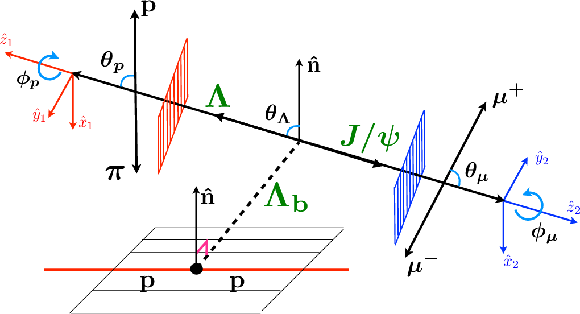
png pdf |
Figure 1:
Definition of the angles used to describe the $\Lambda _{b} \rightarrow J/\psi (\rightarrow \mu ^{+}\mu ^{-})\Lambda ^{0}(\rightarrow p\pi ^{-})$ decay. |

png pdf |
Figure 2:
Distribution of the $p$ vs $\pi $ momentum obtained from the simulation of $\Lambda _{b}\to J/\psi \Lambda (p \pi ^{-})$ (and complex conjugate) decays. Events lie always above the green line, ie., the $p^{+}$ ($p^{-}$) momentum is always greater than $\pi ^{-}$ ($\pi ^{+}$) momentum. |

png pdf |
Figure 3-a:
Invariant mass distribution of $\Lambda_b$ (a and c) and $\overline{\Lambda}_b$ (b and d) candidates in (a-b) 2011 and (c-d) 2012 samples. The solid blue line represents the fit result. The signal (background) projection is shown with a dashed (dot-dashed) red (blue) line. |

png pdf |
Figure 3-b:
Invariant mass distribution of $\Lambda_b$ (a and c) and $\overline{\Lambda}_b$ (b and d) candidates in (a-b) 2011 and (c-d) 2012 samples. The solid blue line represents the fit result. The signal (background) projection is shown with a dashed (dot-dashed) red (blue) line. |
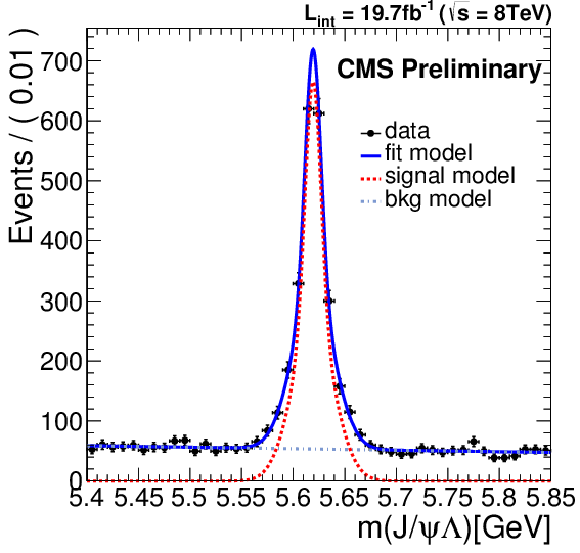
png pdf |
Figure 3-c:
Invariant mass distribution of $\Lambda_b$ (a and c) and $\overline{\Lambda}_b$ (b and d) candidates in (a-b) 2011 and (c-d) 2012 samples. The solid blue line represents the fit result. The signal (background) projection is shown with a dashed (dot-dashed) red (blue) line. |
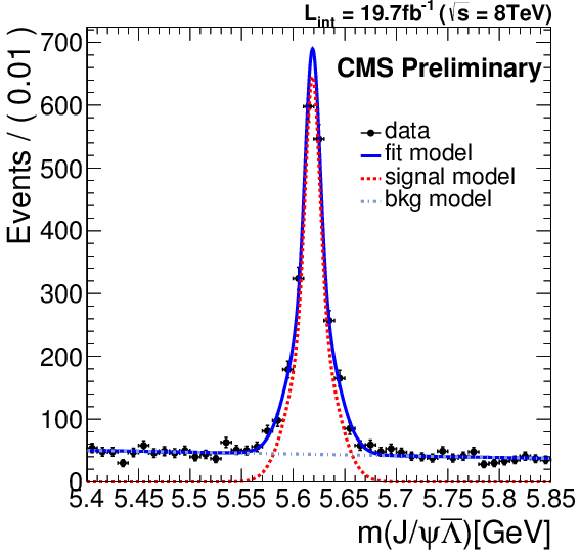
png pdf |
Figure 3-d:
Invariant mass distribution of $\Lambda_b$ (a and c) and $\overline{\Lambda}_b$ (b and d) candidates in (a-b) 2011 and (c-d) 2012 samples. The solid blue line represents the fit result. The signal (background) projection is shown with a dashed (dot-dashed) red (blue) line. |

png pdf |
Figure 4-a:
Angular efficiencies for $\cos\theta _{\Lambda }$, $\cos\theta _{p}$, $\cos\theta _{\mu }$ (from a to c) obtained from simulated $\Lambda _b \rightarrow J/\psi \Lambda ^0$. The angular efficiencies are parametrized with Chebychev polynomials and are fitted simultaneously to the three angular distributions. |
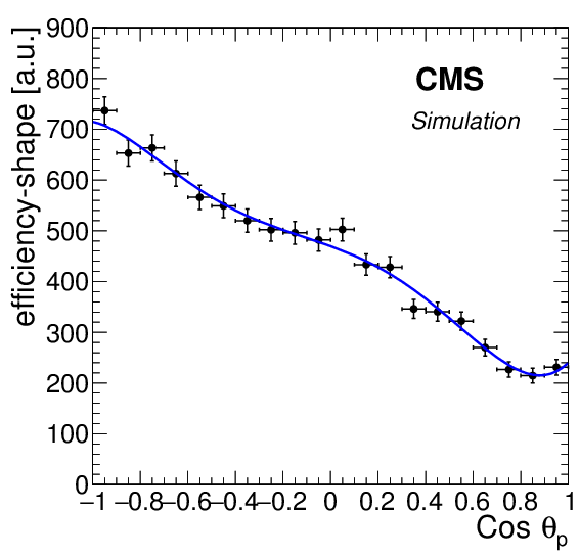
png pdf |
Figure 4-b:
Angular efficiencies for $\cos\theta _{\Lambda }$, $\cos\theta _{p}$, $\cos\theta _{\mu }$ (from a to c) obtained from simulated $\Lambda _b \rightarrow J/\psi \Lambda ^0$. The angular efficiencies are parametrized with Chebychev polynomials and are fitted simultaneously to the three angular distributions. |
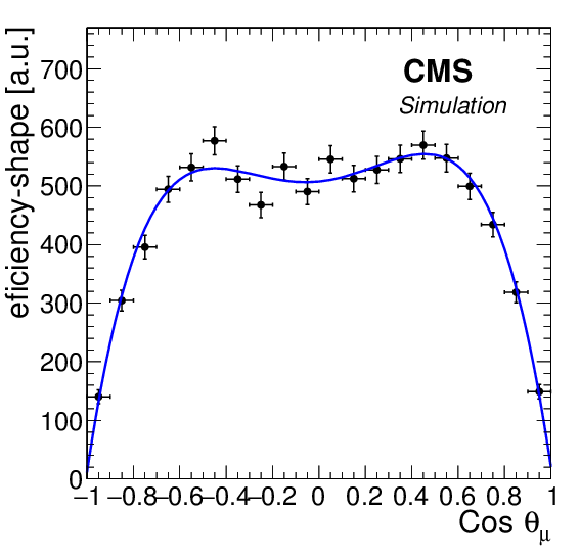
png pdf |
Figure 4-c:
Angular efficiencies for $\cos\theta _{\Lambda }$, $\cos\theta _{p}$, $\cos\theta _{\mu }$ (from a to c) obtained from simulated $\Lambda _b \rightarrow J/\psi \Lambda ^0$. The angular efficiencies are parametrized with Chebychev polynomials and are fitted simultaneously to the three angular distributions. |
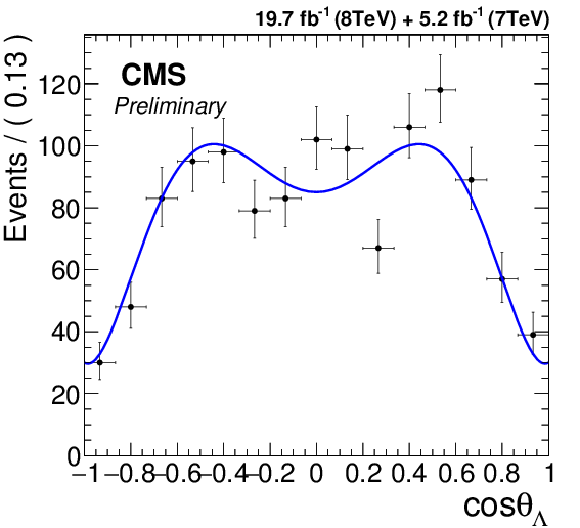
png pdf |
Figure 5-a:
Angular background distributions obtained from the mass sidebands are shown from left to right for $\cos\theta _{\Lambda }$, $\cos\theta _{p}$ and $\cos\theta _{\mu }$. The solid blue lines are the results of the fits. |
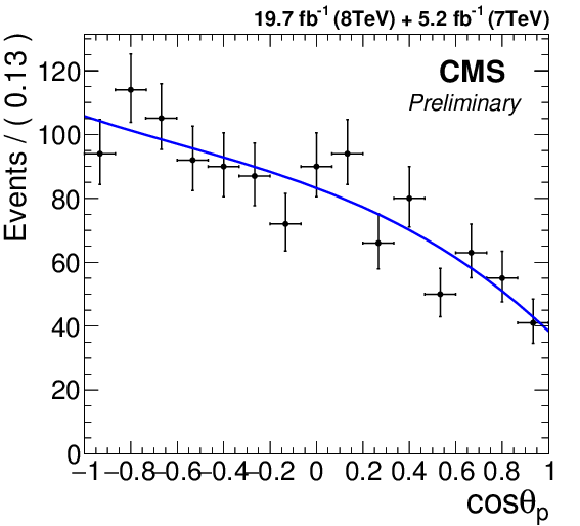
png pdf |
Figure 5-b:
Angular background distributions obtained from the mass sidebands are shown from left to right for $\cos\theta _{\Lambda }$, $\cos\theta _{p}$ and $\cos\theta _{\mu }$. The solid blue lines are the results of the fits. |
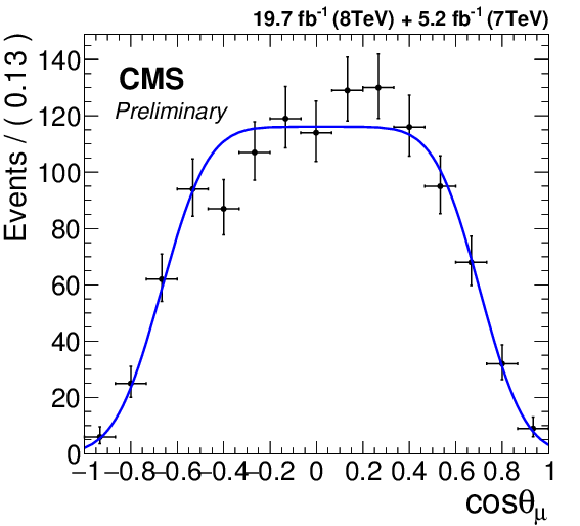
png pdf |
Figure 5-c:
Angular background distributions obtained from the mass sidebands are shown from left to right for $\cos\theta _{\Lambda }$, $\cos\theta _{p}$ and $\cos\theta _{\mu }$. The solid blue lines are the results of the fits. |
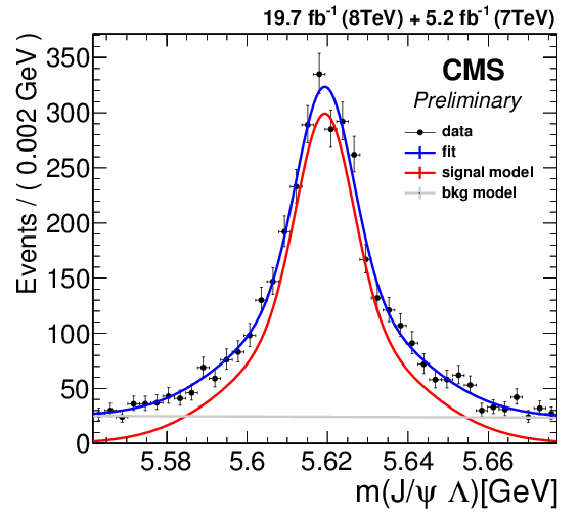
png pdf |
Figure 6-a:
Distributions of $m(J/\psi \Lambda )$, $\cos\theta _{p}$, $\cos\theta _{\Lambda }$, $\cos\theta _{\mu }$ (from a to d) for $\Lambda _b$ candidates in 2011 and 2012 datasets in $m(J/\psi \Lambda )\in [5.56, 5.68]$, with fit results superimposed. The signal (background) component is shown in red (gray). |

png pdf |
Figure 6-b:
Distributions of $m(J/\psi \Lambda )$, $\cos\theta _{p}$, $\cos\theta _{\Lambda }$, $\cos\theta _{\mu }$ (from a to d) for $\Lambda _b$ candidates in 2011 and 2012 datasets in $m(J/\psi \Lambda )\in [5.56, 5.68]$, with fit results superimposed. The signal (background) component is shown in red (gray). |

png pdf |
Figure 6-c:
Distributions of $m(J/\psi \Lambda )$, $\cos\theta _{p}$, $\cos\theta _{\Lambda }$, $\cos\theta _{\mu }$ (from a to d) for $\Lambda _b$ candidates in 2011 and 2012 datasets in $m(J/\psi \Lambda )\in [5.56, 5.68]$, with fit results superimposed. The signal (background) component is shown in red (gray). |
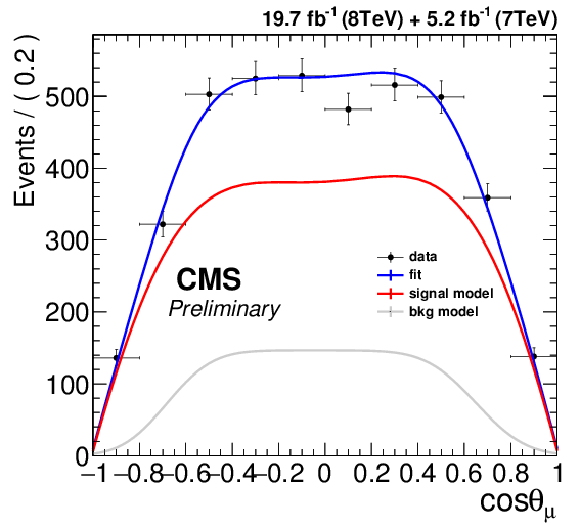
png pdf |
Figure 6-d:
Distributions of $m(J/\psi \Lambda )$, $\cos\theta _{p}$, $\cos\theta _{\Lambda }$, $\cos\theta _{\mu }$ (from a to d) for $\Lambda _b$ candidates in 2011 and 2012 datasets in $m(J/\psi \Lambda )\in [5.56, 5.68]$, with fit results superimposed. The signal (background) component is shown in red (gray). |
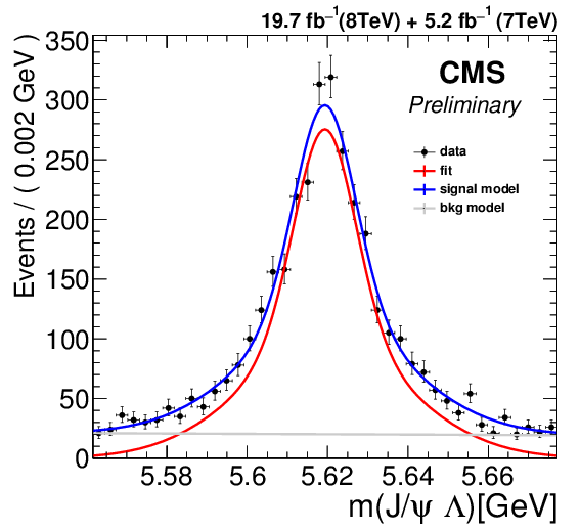
png pdf |
Figure 7-a:
Distributions of $m(J/\psi \overline{\Lambda })$, $\cos\theta _{p}$, $\cos\theta _{\Lambda }$, $\cos\theta _{\mu }$ (from a to d) for $\overline{\Lambda }_b$ candidates in 2011 and 2012 datasets in $m(J/\psi \overline{\Lambda })\in [5.56, 5.68]$, with fit results superimposed. The signal (background) component is shown in red (gray). |
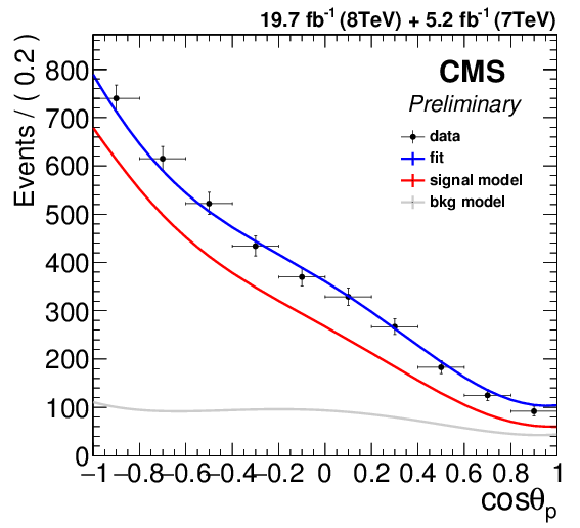
png pdf |
Figure 7-b:
Distributions of $m(J/\psi \overline{\Lambda })$, $\cos\theta _{p}$, $\cos\theta _{\Lambda }$, $\cos\theta _{\mu }$ (from a to d) for $\overline{\Lambda }_b$ candidates in 2011 and 2012 datasets in $m(J/\psi \overline{\Lambda })\in [5.56, 5.68]$, with fit results superimposed. The signal (background) component is shown in red (gray). |

png pdf |
Figure 7-c:
Distributions of $m(J/\psi \overline{\Lambda })$, $\cos\theta _{p}$, $\cos\theta _{\Lambda }$, $\cos\theta _{\mu }$ (from a to d) for $\overline{\Lambda }_b$ candidates in 2011 and 2012 datasets in $m(J/\psi \overline{\Lambda })\in [5.56, 5.68]$, with fit results superimposed. The signal (background) component is shown in red (gray). |

png pdf |
Figure 7-d:
Distributions of $m(J/\psi \overline{\Lambda })$, $\cos\theta _{p}$, $\cos\theta _{\Lambda }$, $\cos\theta _{\mu }$ (from a to d) for $\overline{\Lambda }_b$ candidates in 2011 and 2012 datasets in $m(J/\psi \overline{\Lambda })\in [5.56, 5.68]$, with fit results superimposed. The signal (background) component is shown in red (gray). |
| Tables | |
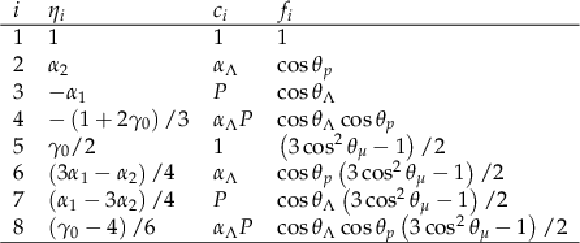
png pdf |
Table 1:
Functions describing the angular distribution of the decay $\Lambda _{b} \rightarrow J/\psi \Lambda ^{0}$, $J/\psi \rightarrow \mu ^+ \mu ^-$, $\Lambda ^{0} \rightarrow p \pi ^-$. |
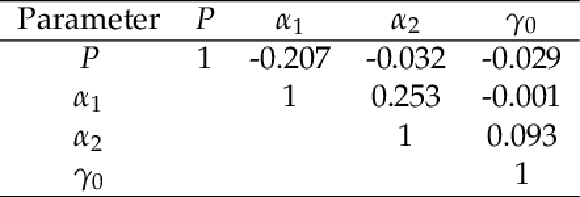
png pdf |
Table 2:
Correlation Matrix of the fitted parameters. |

png pdf |
Table 3:
Summary of systematic uncertainties. |
| Summary |
|
Based on an angular analysis of about 6000 $\Lambda_b \rightarrow J/\psi(\rightarrow\mu^{+}\mu^{-})\Lambda(\rightarrow p\pi^{-})$ decays collected by the CMS experiment in 2011 and 2012, we perform a measurement of the $\Lambda_b$ polarization ($P$), the weak asymmetry parameter of the $\Lambda_b$ decay ($\alpha_1$), the $\Lambda^0$ longitudinal polarization ($\alpha_2$), and a measure of the longitudinal/transverse composition of the $J/\psi$ meson ($\gamma_0$). The measured values are |
| References | ||||
| 1 | T. Mannel and G. A. Schuler | Semileptonic decays of bottom baryons at LEP | PLB279 (1992) 194--200 | |
| 2 | A. F. Falk and M. E. Peskin | Production, decay, and polarization of excited heavy hadrons | PRD49 (1994) 3320--3332 | hep-ph/9308241 |
| 3 | ALEPH Collaboration | Measurement of Lambda(b) polarization in Z decays | PLB365 (1996) 437--447 | |
| 4 | OPAL Collaboration | Measurement of the average polarization of b baryons in hadronic Z0 decays | PLB444 (1998) 539--554 | hep-ex/9808006 |
| 5 | DELPHI Collaboration | Lambda(b) polarization in Z0 decays at LEP | PLB474 (2000) 205--222 | |
| 6 | B. Mele and G. Altarelli | Lepton spectra as a measure of b quark polarization at LEP | PLB299 (1993) 345--350 | |
| 7 | LHCb Collaboration | Measurements of the $ \Lambda_b^0 \to J/\psi \Lambda $ decay amplitudes and the $ \Lambda_b^0 $ polarisation in $ pp $ collisions at $ \sqrt{s} = 7 $ TeV | PLB724 (2013) 27--35 | 1302.5578 |
| 8 | CMS Collaboration | The CMS experiment at the CERN LHC | JINST 3 (2008) S08004 | CMS-00-001 |
| 9 | P. Bialas, J. G. Korner, M. Kramer, and K. Zalewski | Joint angular decay distributions in exclusive weak decays of heavy mesons and baryons | Z. Phys. C57 (1993) 115--134 | |
| 10 | M. Kramer and H. Simma | Angular correlations in $ \Lambda_{b}\to\Lambda+V $: Polarization measurements, HQET and CP violation | NPPS 50 (1996) 125--129, .[125(1996)] | |
| 11 | T. Gutsche et al. | Polarization effects in the cascade decay $ { {\Lambda}}_{b} {\rightarrow} {\Lambda}\mathbf{(} {\rightarrow}p{ {\pi}}^{\mathbf{-}}\mathbf{)}\mathbf{+}J/ {\psi}\mathbf{(} {\rightarrow}{ {\ell}}^{\mathbf{+}}{ {\ell}}^{\mathbf{-}}\mathbf{)} $ in the covariant confined quark model | PRD 88 (Dec, 2013) 114018 | |
| 12 | Particle Data Group Collaboration | Review of Particle Physics | CPC38 (2014) 090001 | |
| 13 | T. Sjostrand, S. Mrenna, and P. Z. Skands | PYTHIA 6.4 Physics and Manual | JHEP 05 (2006) 026 | hep-ph/0603175 |
| 14 | D. J. Lange | The EvtGen particle decay simulation package | NIMA462 (2001) 152--155 | |
| 15 | M. Brun, R. Hagelberg, and J. Lassalle | GEANT1 | CERN-DD-78-2-REV | |
| 16 | E. Gerchtein and M. Paulini | CDF detector simulation framework and performance | 2003 | |
| 17 | M. I. Rikova | Measurement of the $\Lambda_b$ Polarization with pp Collisions at 7 TeV | CERN-THESIS-2013-218 | |
| 18 | CMS Collaboration | Measurement of differential cross sections versus $p_{\mathrm{T}}$ and $|y|$ of $K_0^S$, $\Lambda^0$ and $\Xi^-$ from 7 TeV pp collisions at CMS | CMS-AN-10-084 | |
| 19 | W. Verkerke | The RooFit toolkit for data modelling | eConf C0303241, CHEP03 2003 | |
| 20 | ATLAS Collaboration | Measurement of the parity-violating asymmetry parameter $ { {\alpha}}_{b} $ and the helicity amplitudes for the decay $ { {\Lambda}}_{b}^{0} {\rightarrow}J/ {\psi}{ {\Lambda}}^{0} $ with the ATLAS detector | PRD 89 (May, 2014) 092009 | |
| 21 | G. Hiller, M. Knecht, F. Legger, and T. Schietinger | Photon polarization from helicity suppression in radiative decays of polarized Lambda(b) to spin-3/2 baryons | PLB649 (2007) 152--158 | hep-ph/0702191 |
| 22 | Z. J. Ajaltouni, E. Conte, and O. Leitner | $ \Lambda_{b}^{0} $ decays into $ \Lambda -vector $ | PLB614 (2005) 165--173 | hep-ph/0412116 |

|
Compact Muon Solenoid LHC, CERN |

|

|

|

|

|

|